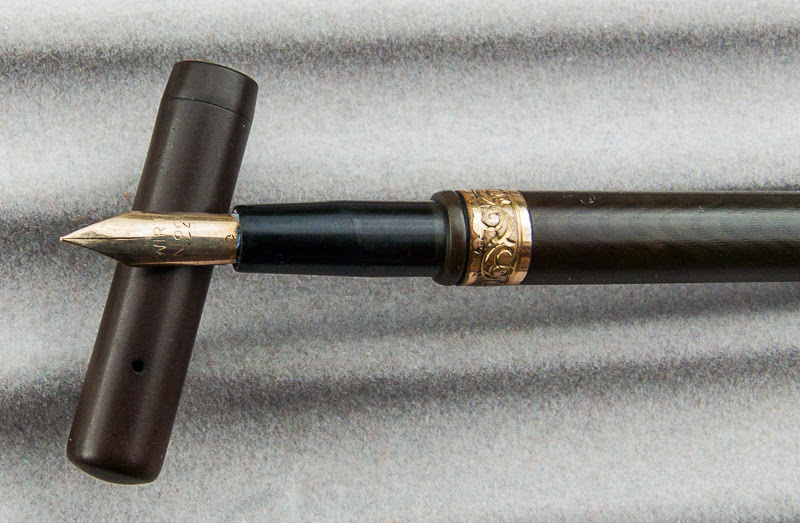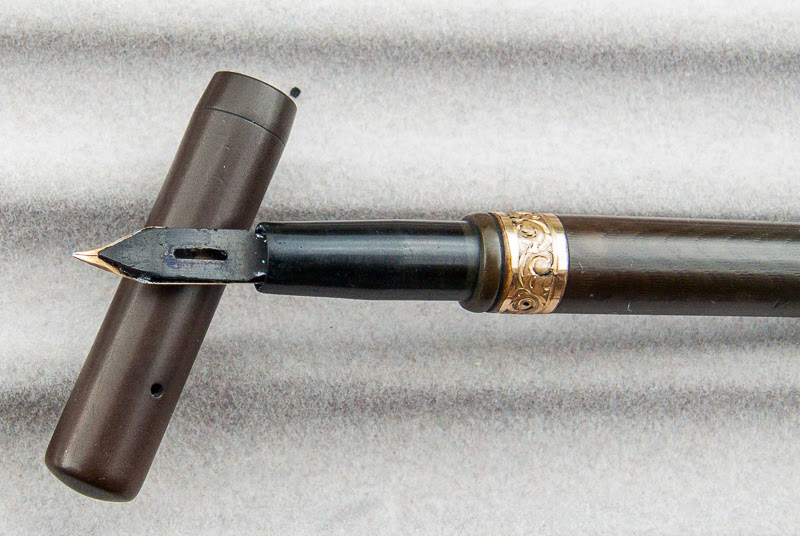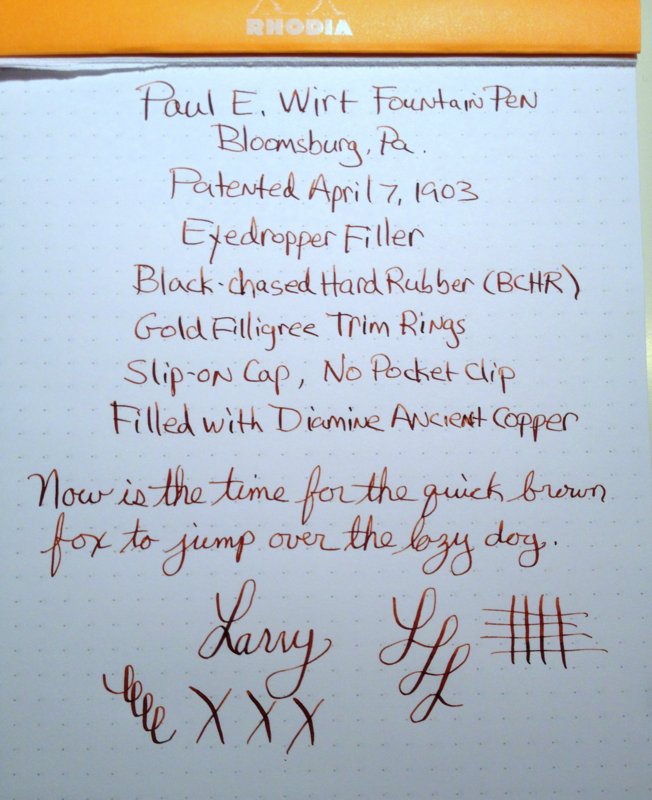I mentioned this pen briefly last month when I first received it as a gift from a friend. I spent some time yesterday cleaning it up and finally got a chance to do some writing with it, so it's time for a short review.
The pen is a Paul E. Wirt eyedropper pen, manufactured sometime in the early 1900s, probably before 1910. The patent date on the barrel inscription is April 7, 1903, so that makes it at least 100 years old.
It's made from Black-Chased Hard Rubber (BCHR), a common material for fountain pens that predate the development of plastics. The original black color has changed to a dark brown due to oxidation and exposure to UV light. The chasing (fine engraved line pattern) on the barrel is worn pretty thin, but is still visible on the entire barrel.
The nib is 14K gold (a Wirt #2) and has a Fine point with some moderate flexibility. The nib is interesting as it has no vent hole, as is common with later pens. There is an oblong vent hole in the feed on the underside of the nib. Earlier Wirts had an overfeed, where the feed actually rested on the top of the nib.
The section assembly unscrews easily for filling with an eyedropper or syringe. The pen has a small slip-on cap and no pocket clip. There are gold filigree trim rings on the top and bottom of the barrel (probably gold-plated).
Total length capped is 5 3/8" and the barrel diameter is 0.36". It's a long, skinny pen!
When I first received the pen, the nib was heavily encrusted with dried ink, so much that you couldn't even tell if it was gold. It cleaned up fairly easily, and a quick dip test showed that it was a good writer. When it came time to clean up the rest of the pen, the task wasn't quite so easy, as the feed and barrel had quite a buildup of dried ink that took many flushings and swabbings to finally remove. I cleaned up the outside and applied a light coating of wax to help prevent further oxidation of the BCHR. Finally I filled it with Diamine Ancient Copper ink, which I thought was an appropriate choice given the age of the pen!
Writing turned out to be a mixed bag. The fine nib was a bit scratchy, particularly on lower-quality paper, and the tip tended to catch on the upstrokes. On better paper (Rhodia and Black N' Red) it performed much better. The nib is semi-flexible and will give some nice line variation when a little pressure is applied (see writing sample below). The biggest drawback is the feed...after two or three sentences, particularly when writing quickly, the feed will run dry. A minute or two of rest will refill the feed and you can continue, but it definitely is not a pen for fast note taking! I imagine the feed could be adjusted by a professional, but I think I'll just keep it as a collectible and only use it for times when I want to write slowly and carefully.
In conclusion, it's a very interesting piece of fountain pen history and will make a nice addition to my collection. It's definitely not a daily carry or frequent writer, but it's a fun little curiosity.
Here's some photos of the pen:




The pen is a Paul E. Wirt eyedropper pen, manufactured sometime in the early 1900s, probably before 1910. The patent date on the barrel inscription is April 7, 1903, so that makes it at least 100 years old.
It's made from Black-Chased Hard Rubber (BCHR), a common material for fountain pens that predate the development of plastics. The original black color has changed to a dark brown due to oxidation and exposure to UV light. The chasing (fine engraved line pattern) on the barrel is worn pretty thin, but is still visible on the entire barrel.
The nib is 14K gold (a Wirt #2) and has a Fine point with some moderate flexibility. The nib is interesting as it has no vent hole, as is common with later pens. There is an oblong vent hole in the feed on the underside of the nib. Earlier Wirts had an overfeed, where the feed actually rested on the top of the nib.
The section assembly unscrews easily for filling with an eyedropper or syringe. The pen has a small slip-on cap and no pocket clip. There are gold filigree trim rings on the top and bottom of the barrel (probably gold-plated).
Total length capped is 5 3/8" and the barrel diameter is 0.36". It's a long, skinny pen!
When I first received the pen, the nib was heavily encrusted with dried ink, so much that you couldn't even tell if it was gold. It cleaned up fairly easily, and a quick dip test showed that it was a good writer. When it came time to clean up the rest of the pen, the task wasn't quite so easy, as the feed and barrel had quite a buildup of dried ink that took many flushings and swabbings to finally remove. I cleaned up the outside and applied a light coating of wax to help prevent further oxidation of the BCHR. Finally I filled it with Diamine Ancient Copper ink, which I thought was an appropriate choice given the age of the pen!
Writing turned out to be a mixed bag. The fine nib was a bit scratchy, particularly on lower-quality paper, and the tip tended to catch on the upstrokes. On better paper (Rhodia and Black N' Red) it performed much better. The nib is semi-flexible and will give some nice line variation when a little pressure is applied (see writing sample below). The biggest drawback is the feed...after two or three sentences, particularly when writing quickly, the feed will run dry. A minute or two of rest will refill the feed and you can continue, but it definitely is not a pen for fast note taking! I imagine the feed could be adjusted by a professional, but I think I'll just keep it as a collectible and only use it for times when I want to write slowly and carefully.
In conclusion, it's a very interesting piece of fountain pen history and will make a nice addition to my collection. It's definitely not a daily carry or frequent writer, but it's a fun little curiosity.
Here's some photos of the pen:
Last edited:


